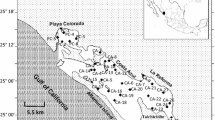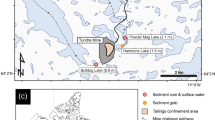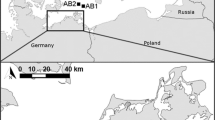Abstract
Purpose
Changes in the chemical conditions of sediment following a resuspension event might lead to release of sequestered pollutants. In the present study, arsenic (As) and iron (Fe) speciation were investigated before and after such an event, in sediment from L'Estaque marina (France). This marina is located near an industrial plant which processed As-bearing ores for several decades.
Materials and methods
Cores (0–60 cm) and surface sediment (0–10 cm) were collected by a diver. Sediment properties along the length of the core were determined by coupling chemical extractions, and diffraction (i.e., X-ray diffraction) and spectroscopic techniques (i.e., micro-X-ray fluorescence, scanning electron microscopy coupled with energy dispersive spectroscopy, Raman spectroscopy, and X-ray absorption near-edge spectroscopy). Laboratory experiments mimicking resuspension and resettlement events were conducted over a period of 3 months in both biotic and abiotic (autoclaved) conditions. In both cases, oxidation proceeded by oxygen diffusion from the top to the bottom of the sediment.
Results and discussion
It was demonstrated that the unperturbed sediment was anoxic. Arsenic, almost fully under its trivalent As(III) form, had a concentration between 194 and 473 μg g−1, and its main carrier phase was the Fe-monosulfide mackinawite; this mineral originated from in situ transformation of Fe oxides, partly emitted by the industrial plant. The observed progressive pyritisation of mackinawite was not accompanied by further reduction of As which means that As remained bound to mackinawite, as incorporation into the pyrite lattice would require that it reduced to its (−I) oxidation state.
After oxidation during the resuspension event, and in abiotic conditions, As was fully pentavalent As(V) in the oxidized zone of the re-settled sediment. On the contrary, in the biotic experiment, the development of a bacterial mat, which consumed oxygen for respiration processes, preserved the sediment from total oxidation. Consequently, As was present under both As(III) and As(V) forms, the first one being minor (∼20 % of total As) in the top of the sediment. The diversity of aioA genes was large, and was similar in the oxidized layer and the deeper black-colored sediment.
Conclusions
These results indicate that biological processes partly control the in situ geochemical system by inducing low redox areas in theoretically oxidized sediments.








Similar content being viewed by others
References
Amirbahman A, Kent DB, Curtis GP, Davis JA (2006) Kinetics of sorption and abiotic oxidation of arsenic(III) by aquifer materials. Geochim Cosmochim Acta 70:533–547
Beak DG, Wilkin RT, Ford RG, Kelly SD (2008) Examination of arsenic speciation in sulfidic solutions using x-ray absorption spectroscopy. Environ Sci Technol 42:1643–1650
Berns AE, Philipp H, Narres HD, Burauel P, Vereecken H, Tappe W (2008) Effect of gamma-sterilization and autoclaving on soil organic matter structure as studied by solid state NMR, UV and fluorescence spectroscopy. Eur J Soil Sci 59:540–550
Bhandari N, Reeder RJ, Strongin DR (2011) Photoinduced oxidation of arsenite to arsenate on ferrihydrite. Environ Sci Technol 45:2783–2789
Boquet E, Boronat A, Ramos-Cormenzana A (1973) Production of calcite (calcium carbonate) crystals by soil bacteria is a general phenomenon. Nature 246(5434):527–529
Bostick B, Fendorf S (2003) Arsenite sorption on troilite (FeS) and pyrite (FeS2). Geochim Cosmochim Acta 67:909–921
Bourdoiseau JA, Jeannin M, Sabot R, Rémazeilles C, Refait P (2008) Characterisation of mackinawite by Raman spectroscopy: effects of crystallisation, drying and oxidation. Corros Sci 50:3247–3255
Bourdoiseau J-A, Jeannin M, Rémazeilles C, Sabot R, Refait P (2011) The transformation of mackinawite into greigite studied by Raman spectroscopy. J Raman Spectrosc 42:496–504
Cantwell MG, Burgess RM (2004) Variability of parameters measured during the resuspension of sediments with a particle entrainment simulator. Chemosphere 56:51–58
Cantwell MG, Burgess RM, King JW (2008) Resuspension of contaminated field and formulated reference sediments Part I: evaluation of metal release under controlled laboratory conditions. Chemosphere 73:1824–1831
Chaillou G, Anschutz P, Dubrulle C, Lecroart P (2007) Transient states in diagenesis following the deposition of a gravity layer: dynamics of O2, Mn, Fe and N-species in experimental units. Aquat Geochem 13:157–172
Chang JS, Lee JH, Kim S (2011) Bacterial aox genotype from arsenic contaminated mine to adjacent coastal sediment: evidences for potential biogeochemical arsenic oxidation. J Hazard Mater 193:233–242
Charlet L, Bosbach D, Peretyashko T (2002) Natural attenuation of TCE, As, Hg linked to the heterogeneous oxidation of Fe(II): an AFM study. Chem Geol 190:303–319
Claff SR, Sullivan LA, Burton ED, Bush RT (2010) A sequential extraction procedure for acid sulfate soils: partitioning of iron. Geoderma 155:224–230
Cook NJ, Ciobanu CL, Pring A, Skinner W, Shimizu M, Danyushevsky L, Saini-Eidukat B, Melcher F (2009) Trace and minor elements in sphalerite: a LA-ICPMS study. Geochim Cosmochim Acta 73:4761–4791
Crouzet C, Kedziorek MAM, Altmann RS, Bourg ACM (2000) Speciation of inorganic sulphur in aquifer sediments contaminated by landfill leachate using chemical extraction techniques. Environ Technol 21:285–296
Daus B, Mattusch J, Paschke A, Wennrich R, Weiss H (2000) Kinetics of the arsenite oxidation in seepage water from a tin mill tailings pond. Talanta 51:1087–1095
Davison W, Seed G (1983) The kinetics of the oxidation of ferrous iron in synthetic and natural waters. Geochim Cosmochim Acta 47:67–79
Downs RT (2006) The RRUFF Project: an integrated study of the chemistry, crystallography, Raman and infrared spectroscopy of minerals. Program and Abstracts of the 19th General Meeting of the International Mineralogical Association in Kobe, Japan O03:13
Durán I, Sánchez-Marín P, Beiras R (2012) Dependence of Cu, Pb and Zn remobilization on physicochemical properties of marine sediments. Mar Environ Res 77:43–49
Eggleton J, Thomas KV (2004) A review of factors affecting the release and bioavailability of contaminants during sediment disturbance events. Environ Int 30:973–980
Emett MT, Khoe GH (2001) Photochemical oxidation of arsenic by oxygen and iron in acidic solutions. Water Res 35:649–656
Farquhar ML, Charnock JM, Livens FR, Vaughan DJ (2002) Mechanisms of arsenic uptake from aqueous solution by interaction with goethite, lepidocrocite, mackinawite, and pyrite: an X-ray absorption spectroscopy study. Environ Sci Technol 36:1757–1762
Gallegos TJ, Hyun SP, Hayes KF (2007) Spectroscopic investigation of the uptake of arsenite from solution by synthetic Mackinawite. Environ Sci Technol 41:7781–7786
Geroni JN, Sapsford DJ (2011) Kinetics of iron (II) oxidation determined in the field. Appl Geochem 26:1452–1457
Gotelli NJ, Entsminger GL (2001) Ecosim: Null Models Software for Ecology, Version 6.0. Acquired Intelligence, & Kesey-Bear http://homepages.together.net/gentsmin/ecosim.htm
Greenfield LJ (1963) Metabolism and concentration of calcium and magnesium and precipitation of calcium carbonate by marine bacterium. Ann N Y Acad Sci 109:23–45
Hall T (1999) BioEdit: a user-friendly biological sequence alignment editor and analysis program for Windows 95/98/NT. Nucleic Acids Symp Ser 41:95–98
Hamamura N, Macur RE, Korf S, Ackerman G, Taylor WP, Kozubal M, Reysenbach AL, Inskeep WP (2009) Linking microbial oxidation of arsenic with detection and phylogenetic analysis of arsenite oxidase genes in diverse geothermal environments. Environ Microbiol 11:421–431
Handley KM, Héry M, Lloyd JR (2009) Redox cycling of arsenic by the hydrothermal marine bacterium Marinobacter santoriniensis. Environ Microbiol 11:1601–1611
Heinrich-Salmeron A, Cordi A, Brochier-Armanet C, Halter D, Pagnout C, Abbaszadeh-Fard E, Montaut D, Seby F, Bertin PN, Bauda P, Arsène-Ploetze F (2011) Unsuspected diversity of arsenite-oxidizing bacteria as revealed by widespread distribution of the aoxB gene in prokaryotes. Appl Environ Microbiol 77:4685–4692
Holmes J (1999) Fate of incorporated metals during mackinawite oxidation in sea water. Appl Geochem 14:277–281
Inskeep WP, Macur RE, Hamamura N, Warelow TP, Ward SA, Santini JM (2007) Detection, diversity and expression of aerobic bacterial arsenite oxidase genes. Environ Microbiol 9:934–943
Jeong HY, Han Y-S, Park SW, Hayes KF (2010) Aerobic oxidation of mackinawite (FeS) and its environmental implication for arsenic mobilization. Geochim Cosmochim Acta 74:3182–3198
Juillot F, Ildefonse P, Morin G, Calas G, Kersabiec AMD, Benedetti M (1999) Remobilization of arsenic from buried wastes at an industrial site: mineralogical and geochemical control. Appl Geochem 14:1031–1048
Kelsey JW, Slizovskiy IB, Peters RD, Melnick AM (2010) Sterilization affects soil organic matter chemistry and bioaccumulation of spiked p,p′-DDE and anthracene by earthworms. Environ Pollut 158:2251–2257
Kim B, McBride MB (2006) A test of sequential extractions for determining metal speciation in sewage sludge-amended soils. Environ Pollut 144:475–482
King DW (1998) Role of carbonate speciation on the oxidation rate of Fe(II) in aquatic systems. Environ Sci Technol 32:2997–3003
Lescure T, Carpentier A, Battaglia-Brunet F, Morel-Desrosiers N (2013) Oxidation of As(III) by the bacterial community of a marine sediment monitored by microcalorimetry. Geomicrobiol J 30:540–548
Loveland PJ, Digby P (1984) The extraction of Fe and Al by 0.1 M pyrophosphate solutions: a comparison of some techniques. J Soil Sci 35:243–250
Lowers HA, Breit GN, Foster AL, Whitney J, Yount J, Md NU, Ad AM (2007) Arsenic incorporation into authigenic pyrite, Bengal basin sediment, Bangladesh. Geochim Cosmochim Acta 71:2699–2717
Loyd SJ, Berelson WM, Lyons TW, Hammond DE, Corsetti FA (2012) Constraining pathways of microbial mediation for carbonate concretions of the Miocene Monterey formation using carbonate-associated sulfate. Geochim Cosmochim Acta 78:77–98
Luther GW (1990) The frontier-molecular-orbital theory approach in geochemical processes In: Stumm W (ed) Aquatic Chemical Kinetics: Reaction Rates of Processes in Natural Waters. Environmental Science and Technology Series. Wiley, New York, USA
Malasarn D, Saltikov CW, Campbell KM, Santini JM, Hering JG, Newman DK (2004) arrA is a reliable marker for As(V) respiration. Science 306:455
Mamindy-Pajany Y, Bataillard P, Seby F, Crouzet C, Moulin A, Guezennec AG, Hurel C, Marmier N, Battaglia-Brunet F (2013) Arsenic in marina sediments from the Mediterranean coast: speciation in the solid phase and occurrence of thioarsenates. Soil Sediment Contam Int J 22:984–1002
Marcus MA, MacDowell AA, Celestre R, Manceau A, Miller T, Padmore HA, Sublett RE (2004) Beamline 10.3.2 at ALS: a hard X-ray microprobe for environmental and materials sciences. J Synchrotron Radiat 11:239–247
McCallum MF, Guhathakurta K (1970) The precipitation of calcium carbonate from seawater by bacteria isolated from Bahama Bank sediments. J Appl Microbiol 33:649–655
Mehra OP, Jackson ML (1958) Iron oxide removal from soils and clays by a dithionite-citrate system buffered with sodium bicarbonate. Clay Clay Miner 7:317–327
Morgan B, Rate AW, Burton ED (2012) Water chemistry and nutrient release during the resuspension of FeS-rich sediments in a eutrophic estuarine system. Sci Total Environ 432:47–56
Mosselmans JFW, Quinn PD, Dent AJ, Cavill SA, Moreno SD, Peach A, Leicester PJ, Keylock SJ, Gregory SR, Atkinson KD, Rosell JR (2009) I18—the microfocus spectroscopy beamline at the Diamond Light Source. J Synchrotron Radiat 16:818–824
Newman DK, Ahmann D, Morel FMM (1998) A brief review of microbial arsenate respiration. Geomicrobiol J 15:255–268
O’Day PA, Rivera N, Root R, Carroll SA (2004) X-ray absorption spectroscopic study of Fe reference compounds for the analysis of natural sediments. Am Mineral 89:572–585
Oremland RS, Stolz JF, Hollibaugh JT (2004) The microbial arsenic cycle in Mono Lake, California. FEMS Microbiol Ecol 48:15–27
Oremland RS, Kulp TR, Blum JS, Hoeft SE, Baesman S, Miller LG, Stolz JF (2005) A microbial arsenic cycle in a salt-saturated, extreme environment. Science 308:1305–1308
Osborne TH, Jamieson HE, Hudson-Edwards KA, Nordstrom DK, Walker SR, Ward SA, Santini JM (2010) Microbial oxidation of arsenite in a subarctic environment: diversity of arsenite oxidase genes and identification of a psychrotolerant arsenite oxidizer. BMC Microbiol 10:205–212
Oscarson DW, Huang PM, Liaw WK (1980) The oxidation of arsenite by aquatic sediments1. J Environ Qual 9:700–703
Öztürk M (1995) Trends of trace metal (Mn, Fe, Co, Ni, Cu, Zn, Cd and Pb) distributions at the oxic–anoxic interface and in sulfidic water of the Drammensfjord. Mar Chem 48:329–342
Peretyazhko T, Sposito G (2006) Reducing capacity of terrestrial humic acids. Geoderma 137:140–146
Peterson ML, Carpenter R (1986) Arsenic distributions in porewaters and sediments of Puget Sound, Lake Washington, the Washington coast and Saanich Inlet, B.C. Geochim Cosmochim Acta 50:353–369
Pohl C, Hennings U (2005) The coupling of long-term trace metal trends to internal trace metal fluxes at the oxic–anoxic interface in the Gotland Basin (57°19,20′N; 20°03,00′E) Baltic Sea. J Mar Syst 56:207–225
Pullin MJ, Cabaniss SE (2003) The effects of pH, ionic strength, and iron–fulvic acid interactions on the kinetics of non-photochemical iron transformations. I. Iron(II) oxidation and iron(III) colloid formation. Geochim Cosmochim Acta 67:4067–4077
Quéméneur M, Heinrich-Salmeron A, Muller D, Lièvremont D, Jauzein M, Bertin P, Garrido F, Joulian C (2008) Diversity surveys and evolutionary relationships of aoxB genes in aerobic arsenite-oxidizing bacteria. Appl Environ Microbiol 74:4567–4573
Quéméneur M, Cébron A, Billard P, Battaglia-Brunet F, Garrido F, Leyval C, Joulian C (2010) Population structure and abundance of arsenite-oxidizing bacteria along an arsenic pollution gradient waters of the Upper Isle River Basin, France. Appl Environ Microbiol 76:4566–4570
Radloff KA, Manning AR, Mailloux B, Zheng Y, Moshiur Rahman M, Rezaul Huq M, Ahmed KM, van Geen A (2008) Considerations for conducting incubations to study the mechanisms of As release in reducing groundwater aquifers. Appl Geochem 23:3224–3235
Root RA, Dixit S, Campbell KM, Jew AD, Hering JG, O’Day PA (2007) Arsenic sequestration by sorption processes in high-iron sediments. Geochim Cosmochim Acta 71:5782–5803. doi:10.1016/j.gca.2007.04.038
Saulnier I, Mucci A (2000) Trace metal remobilization following the resuspension of estuarine sediments: Saguenay Fjord, Canada. Appl Geochem 15:191–210
Savage KS, Tingle TN, O’Day PA, Waychunas GA, Bird DK (2000) Arsenic speciation in pyrite and secondary weathering phases, Mother Lode Gold District, Tuolumne County, California. Appl Geochem 15:1219–1244
Skei JM, Loring DH, Rantala RTT (1996) Trace metals in suspended particulate matter and in sediment trap material from a permanently anoxic fjord—Framvaren, South Norway. Aquat Geochem 2:131–147
Stumm W, Sulzberger B (1992) The cycling of iron in natural environments: considerations based on laboratory studies of heterogeneous redox processes. Geochim Cosmochim Acta 56:3233–3257
Sun YE, Polishchuk A, Radoja U, Cullen WR (2004) Identification and quantification of arsC genes in environmental samples by using real-time PCR. J Microbiol Meth 58:335–349
Tournassat C, Charlet L, Bosbach D, Manceau A (2002) Arsenic(III) oxidation by birnessite and precipitation of manganese(II) arsenate. Environ Sci Technol 36:493–500
Trevors JT (1996) Sterilization and inhibition of microbial activity in soil. J Microbiol Meth 26:53–59
van de Peer Y, De Wachter R (1994) TREECON for Windows: a software package for the construction and drawing of evolutionary trees for the Microsoft Windows environment. Comput Appl Biosci 10:569–570
van den Berg GA, Meijers GGA, van der Heijdt LM, Zwolsman JJG (2001) Dredging-related mobilisation of trace metals: a case study in The Netherlands. Water Res 35:1979–1986
Voelker BM, Sulzberger B (1996) Effects of fulvic acid on Fe(II) oxidation by hydrogen peroxide. Environ Sci Technol 30:1106–1114
Vogt H, Chattopadhyay T, Stolz HJ (1983) Complete first-order Raman spectra of the pyrite structure compounds FeS2, MnS2 AND SiP2. J Phys Chem Solids 44:869–873
Wilkin RT, Ford RG (2006) Arsenic solid-phase partitioning in reducing sediments of a contaminated wetland. Chem Geol 228:156–174
Wolthers M, Charlet L, van Der Weijden CH, van der Linde PR, Rickard D (2005) Arsenic mobility in the ambient sulfidic environment: sorption of arsenic(V) and arsenic(III) onto disordered mackinawite. Geochim Cosmochim Acta 69:3483–3492
Wolthoorn A, Temminghoff EJM, Weng L, van Riemsdijk WH (2004) Colloid formation in groundwater: effect of phosphate, manganese, silicate and dissolved organic matter on the dynamic heterogeneous oxidation of ferrous iron. Appl Geochem 19:611–622
Xu L, Zhao Z, Wang S, Pan R, Jia Y (2011) Transformation of arsenic in offshore sediment under the impact of anaerobic microbial activities. Water Res 45:6781–6788
Zhao Z, Jia Y, Xu L, Zhao S (2011) Adsorption and heterogeneous oxidation of As(III) on ferrihydrite. Water Res 45:6496–6504
Acknowledgments
This study was part of the ASEDMAR project, supported by the French National Research Agency, under reference“2008 CESA-003”. It was performed within the framework of the research network “Arsenic metabolism in Prokaryotes” (GDR2909-CNRS). The authors thank Gaboreau S. for the preparation of the thin sections, and Jean-Prost V. and Ruffier V. for their help during XRD measurements. M. Alleki is thanked for his help during sample preparation. Dr. C. Tournassat is thanked for fruitful discussions. Diamond Light Source is thanked for providing beamtime under award 6841.
Author information
Authors and Affiliations
Corresponding authors
Additional information
Responsible editor: Ian G. Droppo
Rights and permissions
About this article
Cite this article
Bataillard, P., Grangeon, S., Quinn, P. et al. Iron and arsenic speciation in marine sediments undergoing a resuspension event: the impact of biotic activity. J Soils Sediments 14, 615–629 (2014). https://doi.org/10.1007/s11368-013-0829-5
Received:
Accepted:
Published:
Issue Date:
DOI: https://doi.org/10.1007/s11368-013-0829-5




